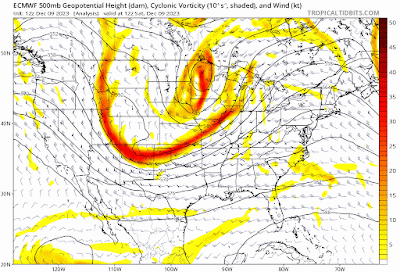This will be a quicker post since I only have a little time today. But we went from a generally all-rain storm to potentially quick heavy snow in less than 24 hours. The South trends on modeling with this short of a lead time are quite remarkable, and I'm not sure if I've seen anything like this, at least recently.
A dynamic system will be approaching from the TN valley, bringing precipitation to the mid-Atlantic and Northeast, a lot of which will be snow. Winter weather advisories are up for those NW of 95 and N of I66.
We will start as rain, but likely switch over to snow and see accumulations in these areas. For us, we get cold enough to snow from dynamic cooling; this system will be very dynamic. It depends on rates, and the boom/bust scenarios are equally likely. The bust scenario would be that we do not get heavy rates and little to no accumulation; the boom is that we get heavy rates for a few hours. Despite marginal temps(33-34), heavy snow rates will accumulate, even on sidewalks/roads if heavy enough. This storm will be more of a latitude and elevation-based storm rather than longitude. That's why central/northern MD is more favored in this setup. Even with heavy rates, your ratios will be low and it will be a wet snow.
.png)
.png)
Precip will likely onset between 5-8 AM, with central MD expected to be all snow by 7-8 AM. Guidance is indicating heavy precip rates, which timed with the morning commute will make it hazardous. It's not more so about the actual amounts, but the heavy rates expected and the timing are perfect to impact the commute. This storm has trended so far south that Maryland gets in on the main snow shield; and not just the backend. Our storm's preformance will depend on these rates.
.png)


There is the potential for 1-3 hours of 1-2"+ rates during the morning commute. With these rates, it will accumulate, even on side roads and paved surfaces. Heavy rates always beat marginal temperatures or any other factor. The previous rain will also make pretreatment impossible. The heaviest rates will likely be just after the switchover(when dynamics are the most favorable), with thundersnow possibilities being hinted by guidance. We won't know what this storm will do until we get there; it is fully dependent on the level and location of banding.
Snow Map + School Predictions:
HREF forecast for the next 24 hours; 2-4" NW of 95 and N of 66 with 4-6" for 70 and north
This is my snow forecast for the event; I think there should generally be at least a solid inch for N of 66; further south should stay under an inch. 3-6" for elevated areas near the MD line and of course, the mountains look like a good call. especially with the recent trends. I would not be surprised at all of the warnings were issued last minute for those regions. The plus in the 1-3 zone is mainly for higher elevated areas. This is a very difficult forecast, with an equal chance for a boom and bust. 1-3" is just in the middle zone and I feel like it will either be a bust/boom. Either way, the morning commute is looking awful, and there will be impacts. As for school impacts...
Prediction: 3 Snowflakes
I'd expect many school impacts, with widespread delays and even closures, especially for counties in the 3-6" zone. The timing of this is perfect to at the very least delay. There is also a 50/50 chance for a closure depending on how long the rates last, and how intense they get. If the rates last for long enough, schools will be forced to close, and there will be enough accumulation on the roads. With the current forecast in place. and the rates guidance is showing, there is really no way schools can open on time tomorrow.
Overall, a nice sneaky event. I think this is going to surprise a lot of people; enjoy the snow!
.png)
.png)






.png)

.png)
.png)
.png)
.png)


.png)



.png)




.png)








.png)


















